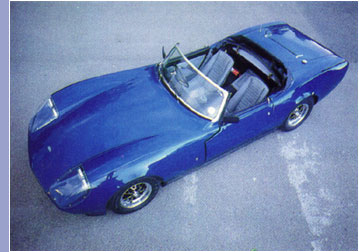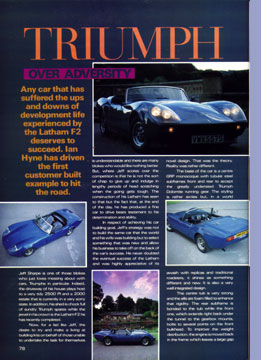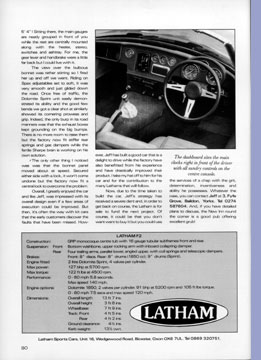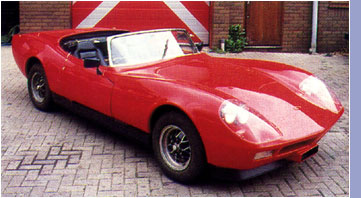|

 By
1990, Latham production was in full swing, and the first
customer cars were starting to reach completion stage.
Once again, it was Ian Hyne, now penning articles for
Kitcars Intrernational, who came to look at two newly
completed examples . . . By
1990, Latham production was in full swing, and the first
customer cars were starting to reach completion stage.
Once again, it was Ian Hyne, now penning articles for
Kitcars Intrernational, who came to look at two newly
completed examples . . .
Any
car that has suffered the ups and downs of development
life experienced by the Latham F2 deserves to succeed.
Ian Hyne has driven the first customer built example
to hit the road.
Jeff
Sharpe is one of those blokes who just loves messing
about with cars, Triumphs in particular. Indeed, the
driveway of his house plays host to a very tidy 2500
PI and a 2000 estate that is currently in a very sorry
state. In addition, his shed is chock full of sundry
Triumph spares while the jewel in his crown is the Latham
F2 he has recently completed.
Now, for a lad like Jeff, the desire to try and make
a living at building kits on behalf of those unable
to undertake the task for themselves is understandable
and there are many blokes who would like nothing better.
But, where Jeff scores over the competition is that
he is not the sort of chap to give up and indulge in
lengthy periods of head scratching when the going gets
tough. The construction of his Latham has seen to that
but the fact that, at the end of the day, he has produced
a fine car to drive bears testament to his determination
and ability.
 In respect of achieving his car building goal, Jeff's
strategy was not to build the same car that the world
and his wife was building but to select something that
was new and allow his business to take off on the back
of the car's success. He never doubted the eventual
success of the Latham and was highly appreciative of
its novel design. That was the theory. Reality was rather
different.
In respect of achieving his car building goal, Jeff's
strategy was not to build the same car that the world
and his wife was building but to select something that
was new and allow his business to take off on the back
of the car's success. He never doubted the eventual
success of the Latham and was highly appreciative of
its novel design. That was the theory. Reality was rather
different.
The basis of the car is a centre GRP monocoque with
tubular steel subframes front and rear to accept the
greatly underrated Triumph Dolomite running gear. The
styling is rather sixties but, in a world awash with
replicas and traditional roadsters, it shines as something
different and new. It is also a very well integrated
design.
The centre tub is very strong and the sills are foam
filled to enhance that rigidity. The rear subframe is
bonded to the tub while the front one, which extends
right back under the tunnel to the gearbox mounts, bolts
to several points on the front bulkhead. To improve
the weight distribution, the engine is moved back in
the frame which leaves a large gap between the radiator
and the engine and this has been utilised for the modified
suspension. The Dolomite donor used a coilspring damper
unit mounted above the upper wishbone but since the
Latham does not have room for this, it has been modified.
The top wishbone is now a rocking arm and the coilspring
damper units are mounted indboard. Simple, clever and
very effective design.
 The Dolomite has been a good choice of donor vehicle
not only for its underrated mechanical base but also
for the many other parts that have been used. The instruments,
heater and controls, door releases, handles, lights,
fuel tank, wheels and tyres have all been utilised saving
quite a few quid on the build. About the only other
parts required are a screen assembly and hood from an
MGB.
The Dolomite has been a good choice of donor vehicle
not only for its underrated mechanical base but also
for the many other parts that have been used. The instruments,
heater and controls, door releases, handles, lights,
fuel tank, wheels and tyres have all been utilised saving
quite a few quid on the build. About the only other
parts required are a screen assembly and hood from an
MGB.
I have been acquainted with the Latham for a long time
now having first seen it in the early stages of development
a few years back in Penzance (see previous article
here). I later drove
the prototype car and was impressed even though it suffered
from a few shortcomings that needed attention prior
to production. (See previous article here)
Then at Stoneleigh this year, the Latham stand was graced
by a beautiful metalflake blue car owned and built by
club sec and magazine editor, Marcus Potts. I also learned
that 15 cars had been delivered to customers and that
Jeff Sharpe's was the first to hit the road. A recent
visit to the infant factory revealed several cars under
construction and yielded a pair of seat runners for
delivery to Jeff Sharpe who lives very near me so we
met to discuss his car.
It is unfortunate that Jeff's route from kit to completed
car has been very far from the plain sailing we all
hope for. The list of faults included the rear subframe
bonded in the wrong position, rear suspension pick up
points inaccurately drilled, front sub-frame badly twisted
so the tub would not sit on its support members and,
when the car was rolling, the wheels fouled the bodywork
front and rear. Thus Jeff has had to indulge in a great
deal of cutting, shutting, welding and redrilling as
well as a good bit of panel dressing.
 Having
seen the photographic evidence of his problems, I can
only say that none of the cars under construction at
the factory were similarly affected. In discussing Jeff's
experience with Julia Latham she could only apologise
and say that his was the first of a batch of five kits
entrusted to sub contractors during the period in which
the company moved from Penzance to Bicester. They very
soon discovered the faults and intervened to rectify
them but Jeff, with his ability and enthusiasm, elected
to sort his car himself. Thereafter, production was
suspended in August 89, the sub contractors were issued
marching orders, new jigs were made and the GRP work,
with which she was also not happy, was brought in house.
These drastic measures and considerable financial expense
have certainly done the trick but, in spite of the dramas
of construction, Jeff is still a staunch fan of the
car and is greatly impressed with driving it. Having
seen the photographic evidence of his problems, I can
only say that none of the cars under construction at
the factory were similarly affected. In discussing Jeff's
experience with Julia Latham she could only apologise
and say that his was the first of a batch of five kits
entrusted to sub contractors during the period in which
the company moved from Penzance to Bicester. They very
soon discovered the faults and intervened to rectify
them but Jeff, with his ability and enthusiasm, elected
to sort his car himself. Thereafter, production was
suspended in August 89, the sub contractors were issued
marching orders, new jigs were made and the GRP work,
with which she was also not happy, was brought in house.
These drastic measures and considerable financial expense
have certainly done the trick but, in spite of the dramas
of construction, Jeff is still a staunch fan of the
car and is greatly impressed with driving it.
It is not a concours car, but that was never the intention.
He wanted to build a car to drive and in that, he has
succeeded. He has used the Dolomite Sprint engine giving
well over 100 mph performance. Needless to say, we didn't
come close to that on the less than perfect roads round
Bradford but the car was quick. It is also torquey which
allows you to drive in a relaxed manner which Jeff likes
best.
 It's
quite a drop to the low driving seat but, once there,
the Latham seats are comfortable and there is room for
taller drivers. If there isn't, the pedals can be moved
and one car has just gone to a customer of 6' 4"
! Sitting there, the main gauges are neatly grouped
in front of you while the rest are centrally mounted
along with the heater, stereo, switches and ashtray.
For me, the gear lever and handbrake were a little far
back but I could live with it. It's
quite a drop to the low driving seat but, once there,
the Latham seats are comfortable and there is room for
taller drivers. If there isn't, the pedals can be moved
and one car has just gone to a customer of 6' 4"
! Sitting there, the main gauges are neatly grouped
in front of you while the rest are centrally mounted
along with the heater, stereo, switches and ashtray.
For me, the gear lever and handbrake were a little far
back but I could live with it.
The view over the bulbous bonnet was rather stirring
so I fired her up and off we went. Riding on Spax adjustables
set to soft, it was very smooth and just glided down
the road. Once free of traffic, the Dolomite Sprint
unit easily demonstrated its ability and the good few
bends we got a clear shot at similarly showed its cornering
prowess and grip. Indeed, the only burp in its road
manners was that the exhaust boxes kept grounding on
the big bumps. There is no more room to raise them but
the factory now fit stiffer rear springs and gas dampers
while the fertile Sharpe brain is working on his own
solution.
The only other thing I noticed was that the bonnet panel
moved about at speed. Secured either side with a lock,
it won't come undone but the factory now fit a central
lock to overcome the problem. Overall, I greatly enjoyed
the car and like Jeff, was impressed with its overall
design even if a few areas of execution could be improved.
But then, it's often the way with kit cars that the
early customers discover the faults that have been missed.
However, Jeff has built a good car that is a delight
to drive while the factory have also benefitted from
his experience and have drastically improved their product.
I take my hat off to him for his car and for the contribution
to the many Lathams that will follow.
Now, due to the time taken to build the car, Jeff's
strategy has received a severe dent and, in order to
get back on course, the Latham is for sale to fund the
next project. Of course, it could be that you don't
want want to buy it but you could use the services of
a chap with the grit, determination, inventiveness and
ability he possesses. Whatever the case, you can contact
Jeff at . . . . and, if you have detailed plans to discuss,
the New Inn round the corner is a good pub offering
excellent grub!
Latham
F2
Construction:
Suspension:
Brakes:
Engine fitted:
Max power:
Max torque:
Performance:
Engine Options:
Dimensions:
|
Specifications
GRP monocoque centre tub with 16 gauge tubular
subframes front and rear.
Front: Bottom wishbone, upper rocking arm
with inboard coilspring damper.
Rear: Four trailing arms, parallel lower,
angled upper, with coil springs and telescopic
dampers
Front: 8" discs. Rear: 8" drums
(1850cc); 9" drums (Sprint).
2 litre Dolomite Sprint, 4 valves per cylinder.
127 bhp at 5700 rpm.
122 ft lbs at 4500rpm.
0- 60 mph 5.8 seconds. Max speed 140 mph.
Dolomite 1850, 2 valves per cylinder. 91 bhp
at 5200 rpm and 105 ft lbs torque.
Overall length: 13 ft 7 ins.
Overall height: 3 ft 8 ins.
Wheelbase: 7 ft 9 ins.
Track: Front: 4 ft 5 ins.
Rear: 4 ft 2 ins.
Ground clearance: 4½ ins.
Kerb weight: 13½ cwt. |
|
 With
thanks to Ian Hyne With
thanks to Ian Hyne
Kitcars International magazine,
August 1990, pages 78-80
Jeff's
car, F2034, is now with a new owner, but still resides
in Yorkshire. The red car (left), which was in the process
of being built when Ian visited the LSC Bicester factory
in 1990, was F2037. It was delivered to its expectant
owner in London in early 1991 and never heard of again.
It was a beautifully constructed car, so any news of
its current whereabouts would be much appreciated!
 Kitcars International is no longer published, but was
absorbed into Kit Car:
Kitcars International is no longer published, but was
absorbed into Kit Car:
|